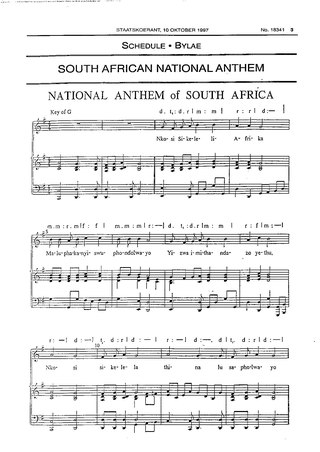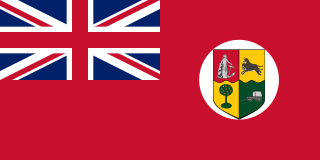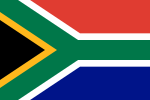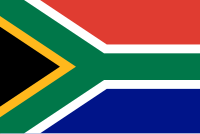
The national anthem of South Africa was adopted in 1997 and is a hybrid song combining extracts of the 19th century Xhosa hymn "Nkosi Sikelel' iAfrika" and the Afrikaans song that was used as the South African national anthem during the apartheid era, "Die Stem van Suid-Afrika", with new English lyrics.

The Union Jack or Union Flag is the de facto national flag of the United Kingdom. The Union Flag was also used as the official flag of several British colonies and dominions before they adopted their own national flags. The flag continues to have official status in Canada, by parliamentary resolution, where it is known as the Royal Union Flag.
"Mungu ibariki Afrika" is the national anthem of Tanzania. It is a Swahili language version of Enoch Sontonga's popular hymn "Nkosi Sikelel' iAfrika".

The flag of South Africa was designed in March 1994 and adopted on 27 April 1994, during South Africa's 1994 general election, to replace the previous flag used from 1928–1994.

The Red Ensign or "Red Duster" is the civil ensign of the United Kingdom of Great Britain and Northern Ireland. It is one of the British ensigns, and it is used either plain or defaced with either a badge or a charge, mostly in the right half.

"Stand and Sing of Zambia, Proud and Free" is the national anthem of Zambia. The tune is taken from the hymn "Nkosi Sikelel' iAfrika", which was composed by Xhosa composer Enoch Sontonga, in 1897. The lyrics were composed after Zambian independence to specifically reflect Zambia, as opposed to Sontonga's lyrics, which refer to Africa as a whole.

The governor-general of the Union of South Africa was the highest state official in the Union of South Africa between 31 May 1910 and 31 May 1961. The Union of South Africa was founded as a self-governing Dominion of the British Empire in 1910 and the office of governor-general was established as the representative of the monarch. Fifty-one years later the country declared itself a republic and the historic link with the British monarchy was broken. The office of governor-general was abolished.

Die Stem van Suid-Afrika, also known as "The Call of South Africa" or simply "Die Stem", was the national anthem of South Africa during the apartheid era. There are two versions of the song, one in English and the other in Afrikaans, which were in use early on in the Union of South Africa alongside God Save the Queen and as the sole anthem after South Africa became a republic. It was the sole national anthem from 1957 to 1994, and shared co-national anthem status with "God Save the King/Queen" from 1938 to 1957. After the end of apartheid, it was retained as a co-national anthem along with "Nkosi Sikelel' iAfrika" until 1997, when a new hybrid song incorporating elements of both songs was adopted as the country's new national anthem, which is still in use.

The flag of the British Overseas Territory of Bermuda as a red ensign was first adopted on 4 October 1910. It is a British Red Ensign with the Union Flag in the upper left corner, and the coat of arms of Bermuda in the lower right. Prior to this like most of the British colonies at the time it adopted a blue ensign with a seal that depicted a dry dock with three sailing ships. In 1999, the flag was changed to its current form, with an enlarged coat of arms.

The national flag of Zambia was adopted upon independence on 24 October 1964, by the first Republican President Dr. Kenneth David Kaunda. Before that, Zambia was the British protectorate of Northern Rhodesia and used a defaced Blue Ensign as its flag.

"Nkosi Sikelel' iAfrika" is a Christian hymn originally composed in 1897 by Enoch Sontonga, a Xhosa clergyman at a Methodist mission school near Johannesburg.

The current state flag of New South Wales was officially adopted in 1876. The flag is based on the defaced British Blue Ensign with the state badge located in the fly. The badge, based on the coat of arms, is a white disc with the cross of St George, a golden lion passant guardant in the centre of the cross and an eight-pointed gold star on each arm of the cross.

"Namibia, Land of the Brave" is the national anthem of Namibia, adopted in December 1991. It was composed by Axali Doëseb, who was the director of a traditional music group from the Kalahari desert. Doëseb was chosen to compose it after winning a contest held after Namibia became independent in 1990.

Enoch Mankayi Sontonga was a South African composer, who is best known for writing the Xhosa hymn "Nkosi Sikelel' iAfrika", which, in abbreviated version, has been sung as the first half of the national anthem of South Africa since 1994. Previously, it had been the official anthem of the African National Congress since 1925. It was also adopted by South Africa's newly formed northern neighbour, Zimbabwe and translated into Shona, "Ishe Komborera Afrika" from 1980 until 1994.

The flag of Rhodesia changed with political developments in the country. At independence in 1965 the recently adopted flag of Southern Rhodesia was used, until a new flag was adopted in 1968. The 1968 flag remained in use following the declaration of the republic in 1970 and it was also initially the flag of Zimbabwe Rhodesia until a new flag was adopted in September 1979.

The South African Red Ensign was the civil ensign of Union of South Africa from 1910 to 1951. From 1910 to 1928, the flag was also viewed as the unofficial flag of South Africa. The design of the flag was a red ensign defaced with the coat of arms of South Africa on a white disc.

The coat of arms of Natal was the official heraldic symbol of Natal as a British colony from 1907 to 1910, and as a province of South Africa from 1910 to 1994. It is now obsolete.

The flag of South Africa from 1928 to 1994 was the flag of the Union of South Africa from 1928 to 1961 and later the flag of the Republic of South Africa until 1994. It was also the flag of South West Africa to 1990, when that territory was under South African administration. Based on the Dutch Prince's Flag, it contained the flag of the United Kingdom, the flag of the Orange Free State, and the flag of the South African Republic (respectively) in the centre. A nickname for the flag was Oranje, Blanje, Blou.

The first coat of arms of South Africa was granted to the Union of South Africa by King George V and later amended by the British College of Arms. It contained representation of the four provinces within the Union. The coat of arms was later retained by the Republic of South Africa after independence and for a period until after the end of apartheid, until being retired in 2000. The 1910 coat of arms was replaced in 2000 by the current coat of arms of South Africa.
























